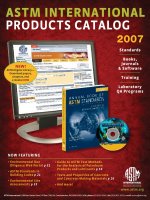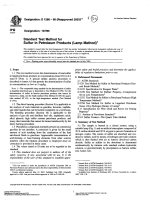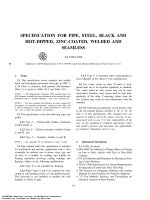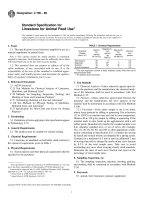Astm d1194
Bạn đang xem bản rút gọn của tài liệu. Xem và tải ngay bản đầy đủ của tài liệu tại đây (207.61 KB, 3 trang )
fly
AMERICAN SOCIETY FOR TESTING AND MATERIALS
1916 Race St. Philadelphia, Pa 19103
fieprinted from the Annual Book of ASTM Standards. Copyright ASTM
Ht not fisted in the current combined index, will appear in the next adition
Designation: D 1194 - 94
Standard Test Method for
Bearing Capacity of Soil for Static Load and Spread Footings’
This standard is issued under the fixed designation D 1194; the number immediately following the designation indicates the year of
original adoption or, in the case of revision, the year of last revision, A number in parentheses indicates the year of last reapproval. A
superscript epsilon (¢) indicates an editorial change since the last revision or reapproval,
This standard has been approved for use by agencies of the Department of Defense. Consult the DoD Index of Specifications and
Standards for the specific year of issue which has been adopted by the Department of Defense.
1. Scope
1.1 This test method covers estimation of the bearing
capacity of soil in place by means of field loading tests. This
test method
can
be used
as part of a procedure
for soil
investigation for foundation design. It gives information on
the soil only to a depth equal to about two diameters of the
bearing plate, and takes into account only part of the effect
of time.
1.2 The values stated in inch-pound units are to be
regarded as the standard. The SI units given in parentheses
are for information only.
1.3 This standard does not purport to address ail of the
safety concerns, if any, associated with its use. It is the
responsibility of the user of this standard to establish appro-
priate safety and health practices and determine the applica-
bility of regulatory limitations prior to use.
2. Significance and Use
2.1
This
test
method
is used
to estimate
the
bearing
capacity of a soil under field loading conditions for a specific
loading plate and depth of embedment. The bearing capacity
of a soil is not simply a soil strength parameter, but it also
depends on the magnitude and distribution of the load,
dimension, and geometry of the loading plate and depth of
embedment (or elevation of testing). This bearing capacity
can be used
foundations.
in soil investigations
and
for the design
of
3.2. Hydraulic or Mechanical Jack Assembly of sufficient
estimated
load for the specific soil conditions involved, but not less
than 50 tons (440 kN) in any case, and at least one device,
such as a pressure gage, electronic load cell, or proving ring,
for measuring the force exerted by the jack. The forcemeasuring devices should be capable of recording the load
with an error not exceeding +2 % of the load increment
used.
3.3 Bearing Plates—Three circular steel bearing plates,
' This test method is under the jurisdiction of ASTM Committee D-18 on Soil
and Rock and is the direct responsibility of Subcommittee D18.10 on Bearing
Tests of Soils in Place.
minimum and maximum diameter specified or square steel
bearing plates of equivalent area, As an alternative, three
small concrete footings of the size mentioned or larger can be
cast in-situ. Such footings must have a depth of not less than
two thirds of their width.
3.4 Settlement-Recording Devices, such as dial gages,
capable
of measuring
settlement
of the test plates to an
accuracy of at least 0.01 in. (0.25 mm).
3.5 Miscellaneous Apparatus, including loading columns,
steel shims, and other construction tools and equipment
required for preparation of the test pits and loading apparatus.
Note 1—Testing assemblies may vary widely, depending on job
conditions, testing requirements, and equipment available. The testing
assembly and program should be planned in advance and approved by
the supervising engincer, and in general can permit considerable latitude
in details within the specific requirements noted above and outlined in
the following test procedure. A typical assembly for conducting load
tests is illustrated in Fig. 1.
4, Procedure
4.1 Selection of Test Areas—Base the selection of repre-
sentative
test
areas
for
bearing
tests
on
the
results
of
exploratory borings and on the design requirements of the
structure. Unless otherwise specified, make the load test at
the elevation of the proposed footings and under the same
3. Apparatus
3.1 Leading Platforms or Bins of sufficient size and
strength to supply the estimated total load required or
equivalent means of supplying the total load reaction anticipated.
capacity to provide and maintain the maximum
not less than 1 in. (25 mm) in thickness and varying in
diameter from 12 to 30 in. (305 to 762 mm), including the
Current edition approved March 15, (994. Published May 1994, Originally
published as D 1194 ~ 52 T. Last previous edition D 1194 ~ 72 (1987).
conditions to which the proposed footings will be subjected.
At the selected elevation place the bearing plates at the same
relative depths (depths expressed in plate diameters) as the
actual footing.
Nore 2—For footings placed under permanently excavated basements the depth of the actual footing is construed as the depth from the
basement level or depth over which the surcharge is permanently acting,
father than the depth from the ground surface.
Nore 3-~If the mentioned condition of equal relative depth cannot
be met for practical reasons, the test results must be interpreted by using
an appropriate theory of bearing capacity, Also make corrections for the
effects of the shape and size of the footing and the effects of the water
table as appropriate.
4.2 Test Pits—At least three test locations are required,
and the distance between test locations shall not be less than
five times the diameter of the largest plate used in the tests.
Carefully level and clean the areas to be loaded by the test
plates or footings so that the loads are transmitted over the
entire contact areas on undisturbed soil. Prior to loading,
protect test pits and areas against moisture changes in the soil
unless it is expected that wetting of the soil will occur at some
future time, as in the case of hydraulic structures. In this
(Ÿ? D 1194
Compression
Lead
Post
Picttorm
Timber Cabbing
Reterence
(Ee Beom
ETRE
ES BF YEE PE
Rh Compression Post
Ñ
fnght Plate
RST.
Anchor Piles
Re
È
_PiợtE
+
4
Anchor Đods-
|
RITE
ì
eechon Beom
~~ Compression
beri
i
Settlement
i
Recording
Boord
Post
i
~B0lland
Straightedge
Reference
Soackel
doiml
Plote
Beam~
Compression
l
FIG. 1
Post
Typical Setup for Conducting Static Load Tests
case, prewet the soil in the area to the desired extent to a
depth not less than twice the diameter of the largest bearing
plate.
4.3 Loading Platforms—Support the loading platforms or
bins by cribbing or other suitable means, at points as far
tude. If sufficient load is available, continue the test until the
less than 8 ft (2.4 m). The total load required for the test shall
be available at the site before the test is started.
tion ceases or for a period not smaller than the time interval
of loading.
removed from the test area as practicable, and preferably not
4.4 Dead Load-—Weigh
and
record as dead weight all
equipment used, such as steel plates, loading column and
jack, etc., that are to be placed on the test area prior to the
application of the load increments.
4.5 Reference Beam—Independently support the beam
supporting dial gages or other settlement-recording devices as
far as practicable, but not less than 8 ft (2.4 m) from the
center of the loaded area.
4.6 Load Increments—Apply the load to the soil in
cumulative equal increments of not more than 1.0 ton/ft?
(95 kPa), or of not more than one tenth of the estimated
bearing capacity of the area being tested. Accurately measure
each load, and apply it in such a manner that all of the load
reaches the soil as a static load, without impact, fluctuation,
or eccentricity.
4.7
each
Time Interval of Loading--After the application of
load increment,
maintain
the cumulative
selected time interval of not fess than 15 min.
load for a
Note 4~-Longer time intervals may be determined by maintaining
the load until the settlement has ceased or the rate of settlement becomes
uniform. However, maintain any type of time interval so selected for
each load increment in all tests of any series.
total settlement reaches at least 10 % of the plate diameter,
unless a well-defined failure load is observed. After completion of observations for the last load increment, release this
applied load in three approximately equal decrements.
Continue recording rebound deflections until the deforma-
Nore 5—The following alternative loading procedure is also permissible: Apply the load to the soil in increments corresponding to
settlement increments of approximately 0.5 % of the plate diameter.
After the application of each settlement increment, measure the load at
some fixed time intervals, for example, 30s, 1 min, 2 min, 4 min, 8 min,
and 15 min, after load application, until the variation of the load ceases
or until the rate of variation of the load, on a load versus logarithmoftime scale becomes linear. Continue loading in selected settlement
increments, Termination of tests and unloading are made in the same
manner as in 4.9.
5. Report
5.1 In addition to the continuous listing of all time, load,
and settlement data for each test, as prescribed in Section 3,
report all associated conditions and observations pertaining
to the test, including the following:
5.1.1
Date,
3.1,5
Irregularity in routine procedure.
$1 „2 List of personnel,
3.1.3 Weather conditions,
3.14 Air temperature at time of Joad increments, and
record of all settlements. Make settlement measurements as
soon as possible before and after the application of each load
increment, and at such equal time intervals, while the load is
6. Precision and Bias
6.1 The precision and bias of this test method for determining the bearing capacity of soil in place by means of a
field loading test has not been determined. No available
4.9 Termination of Tests—Continue each test until a peak
The variability of the soil and the resulting disturbance of the
4.8 Measurement
of
Settlemeni—Keep
a
continuous
being held constant, as will provide not less than
settlement measurements between load applications.
six
load is reached or until the ratio of load increment to
settlement increment reaches a minimum, steady magni-
methods provide absolute values for the bearing capacity of
soil in place against which this method can be compared.
soil under the loading plate do not allow for the repetitive
duplication of test results required to obtain a meaningful
dy b 1194
statistical evaluation. The subcommittee is seeking pertinent
data from users of this method which may be used to develop
meaningful statements of precision and bias.
7. Keywords
7.1 bearing capacity; bearing plate; deflection; settlement
The American Society for Tasting and Materials takes rio position respecting the validity of any patent rights asserted in connection
with any item mentioned in this standard. Users of this standard are exprassiy advised that determination of the validity of any such
patent rights, and the risk of infringement of such rights, are entirely their own: responsibility.
This standard is subject to revision at any time by the responsible technical committae and must be reviewed every live years and
if not revised, either reapproved or withdrawn. Your comments ara invited either for ravision of this standard or for additional standards
and should be addressed to ASTM Headquarters. Your comments will receive careful consideration at @ meeting of the responsible
technical committes, which you may attend. If you fee! that your comments have not received a fair hearing you should make your
views known to the ASTM Committee on Standards, 1916 Race Sv., Philadelphia, PA 19103.









